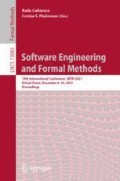Abstract
Runtime verification is used for monitoring the execution of systems, e.g. checking sequences of reported events against formal specifications. Typically the specification refers to the individual monitored events. In this work we perceive the events as defining intervals, each defined by a begin and a subsequent end event. Allen’s logic allows assertions about the relationship between such named intervals. We suggest a formalism that extends Allen’s logic into a first-order logic that allows quantification over intervals; in addition, intervals can carry data. We provide a monitoring algorithm and describe an implementation and experiments performed with it. We furthermore describe an alternative method for monitoring properties in this logic, by translating them into first-order past-time temporal logic, monitored with the tool DejaVu.
The research performed by the first author was carried out at Jet Propulsion Laboratory, California Institute of Technology, under a contract with the National Aeronautics and Space Administration. The research performed by the second and third authors was partially funded by Israeli Science Foundation grant 1464/18: “Efficient Runtime Verification for Systems with Lots of Data and its Applications”.
Access this chapter
Tax calculation will be finalised at checkout
Purchases are for personal use only
Notes
- 1.
Monitoring Allen logic modal intervals.
- 2.
In the implementation the same number of bits are used for all variables: \(k_1 = k_2 = \ldots = k_n\).
- 3.
A refined algorithm can reuse enumerations that were used for values that can no longer affect the verdict of the RV process, see [12].
References
Allen, J.F.: Maintaining knowledge about temporal intervals. Commun. ACM 26(11), 832–843 (1983)
Alpern, B., Schneider, F.B.: Recognizing safety and liveness. Distrib. Comput. 2(3), 117–126 (1987)
D’Angelo, B., et al.: LOLA: runtime monitoring of synchronous systems. In: TIME 2005, pp. 166–174 (2005)
Barringer, H., Havelund, K.: TraceContract: a scala DSL for trace analysis. In: Butler, M., Schulte, W. (eds.) FM 2011. LNCS, vol. 6664, pp. 57–72. Springer, Heidelberg (2011). https://doi.org/10.1007/978-3-642-21437-0_7
Basin, D.A., Klaedtke, F., Müller, S., Zalinescu, E.: Monitoring metric first-order temporal properties. J. ACM 62(2), 45 (2015)
Bryant, R.E.: Symbolic boolean manipulation with ordered binary-decision diagrams. ACM Comput. Surv. 24(3), 293–318 (1992)
CUDD BDD package [https://davidkebo.com/cudd]
The ’dd’ Python package for manipulating Binary decision diagrams (BDDs) and Multi-valued decision diagrams (MDDs) [https://github.com/tulip-control/dd]
Decker, N., Leucker, M., Thoma, D.: Monitoring modulo theories. J. Softw. Tools Technol. Transfer 18(2), 205–225 (2016)
Hallé, S., Villemaire, R.: Runtime enforcement of web service message contracts with data. IEEE Trans. Serv. Comput. 5(2), 192–206 (2012)
Halpern, J.Y., Shoham, Y.: A propositional modal logic of time intervals. J. ACM 38(4), 935–962 (1991)
Havelund, K., Peled, D., Ulus, D.: First-order temporal logic monitoring with BDDs. In: FMCAD 2017, pp. 116–123 (2017)
Havelund, K., Roşu, G.: Synthesizing monitors for safety properties. In: Katoen, J.-P., Stevens, P. (eds.) TACAS 2002. LNCS, vol. 2280, pp. 342–356. Springer, Heidelberg (2002). https://doi.org/10.1007/3-540-46002-0_24
Kauffman, S., Havelund, K., Joshi, R., Fischmeister, S.: Inferring event stream abstractions. Formal Methods Syst. Des. 53(1), 54–82 (2018)
Kim, M., Kannan, S., Lee, I., Sokolsky, O.: Java-MaC: a run-time assurance tool for Java. In: Proceedings of the 1st International Workshop on Runtime Verification (RV’01), Elsevier, ENTCS, vol. 55, no. 2 (2001)
Kupferman, O., Vardi, M.Y.: Model checking of safety properties. Formal Methods Syst. Des. 19(3), 291–314 (2001)
Mars Curiosity Rover [https://mars.nasa.gov/msl]
Meredith, P.O., Jin, D., Griffith, D., Chen, F., Rosu, G.: An overview of the MOP runtime verification framework. J. Softw. Tools Technol. Transfer 14, 249–289 (2011). https://doi.org/10.1007/s10009-011-0198-6
MonAmi tool source code [https://github.com/moraneus/MonAmI]
DejaVu tool source code [https://github.com/havelund/dejavu]
nfer in C [http://nfer.io]
nfer in Scala [https://github.com/rv-tools/nfer]
Reger, G., Cruz, H.C., Rydeheard, D.: MarQ: monitoring at runtime with QEA. In: Baier, C., Tinelli, C. (eds.) TACAS 2015. LNCS, vol. 9035, pp. 596–610. Springer, Heidelberg (2015). https://doi.org/10.1007/978-3-662-46681-0_55
Rosu, G., Bensalem, S.: Allen Linear (Interval) Temporal Logic - Translation to LTL and Monitor Synthesis. CAV 2006, pp. 263–277 (2006)
Sistla, A.P.: Theoretical Issues in the Design and Analysis of Distributed Systems, Ph.D Thesis, Harvard University (1983)
Sistla, A.P., Vardi, M.Y., Wolper, P.: The complementation problem for Büchi automata with applications to temporal logic. In: Brauer, W. (ed.) ICALP 1985. LNCS, vol. 194, pp. 465–474. Springer, Heidelberg (1985). https://doi.org/10.1007/BFb0015772
Stockmeyer, L.J., Meyer, A.R.: Word Problems Requiring Exponential Time: Preliminary Report, STOC, 1973, pp. 1–9 (1973)
Thomas, W.: Automata on infinite objects. In: Handbook of Theoretical Computer Science, Volume B: Formal Models and Sematics (B), pp. 133–191 (1990)
Ulus, D., Maler, O.: Specifying timed patterns using temporal logic. In: 21st International Conference on Hybrid Systems: Computation and Control, pp. 167–176. ACM (2018)
Author information
Authors and Affiliations
Editor information
Editors and Affiliations
Rights and permissions
Copyright information
© 2021 Springer Nature Switzerland AG
About this paper
Cite this paper
Havelund, K., Omer, M., Peled, D. (2021). Monitoring First-Order Interval Logic. In: Calinescu, R., Păsăreanu, C.S. (eds) Software Engineering and Formal Methods. SEFM 2021. Lecture Notes in Computer Science(), vol 13085. Springer, Cham. https://doi.org/10.1007/978-3-030-92124-8_4
Download citation
DOI: https://doi.org/10.1007/978-3-030-92124-8_4
Published:
Publisher Name: Springer, Cham
Print ISBN: 978-3-030-92123-1
Online ISBN: 978-3-030-92124-8
eBook Packages: Computer ScienceComputer Science (R0)

